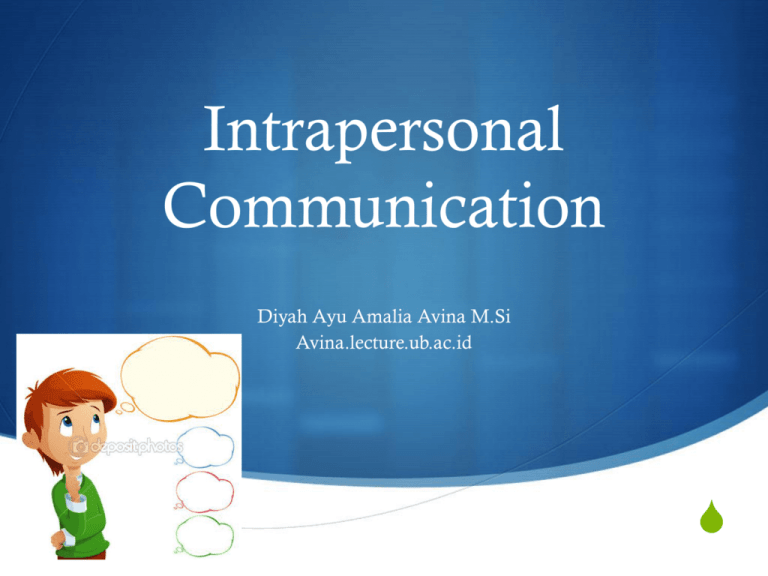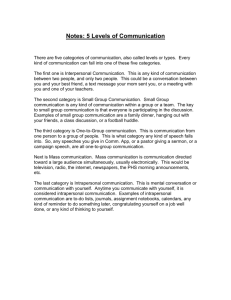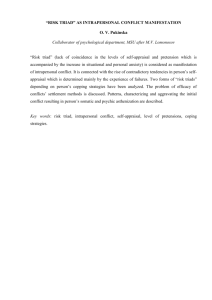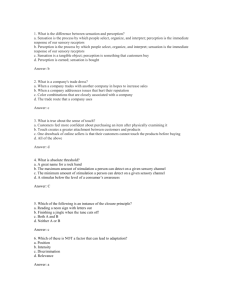Intrapersonal Communication
advertisement

Intrapersonal Communication Diyah Ayu Amalia Avina M.Si Avina.lecture.ub.ac.id S Intrapersonal ? S Definition of INTRAPERSONAL : occurring within the individual mind or self <intrapersonal concerns of the aged> <http://www.merriamwebster.com/dictionary/intrapersonal> Intrapersonal Communication S Communication with ourselves or our self talk (Wood, 2001 p 26) S Related with thinking – information processing Intrapersonal communication? S Information processing within oneself Intrapersonal communication : a Process Sensation Perception Memory Thinking S Intrapersonal communication takes place within a single person, often for the purpose of clarifying ideas or analyzing a situation. S Other times, intrapersonal communication is undertaken in order to reflect upon or appreciate something. Sensation Catching or gathering stimulus Part of perception Sensation refers the immediate response of our sensory receptors (eyes, ears, nose, mouth, finger) to basic stimuli such as light, color, sound, odor, and texture(Solomon. 2004:45) S SENSATION starve Internal Tootache Remember about something Type of stimulus watching infotainment External Listen to someone else who give you an order www.themegallery.com Vision smell Sensory system Sound Touch taste • Colourful, fancy : – younger feel ; • red – passsion ,lust • ; pink – romance; yellow—happy, spirit- starve ; blue – relaxing, positive feeling of the future, etc • mourn= • black –west countries ; white – east countries • woman – mostly bright colour ; oattern sensitive • Age – adults (older people) has limiatation of ability to see the colour ex – old people choose white car (LEXUS = 60% WHITE) • Smell creates emotion and feelings • • • • Ex : aromatherapy for relaxation Food aroma create hunger feelings Thinking the other - based on memories • Level of wordiness, intonation, pitch, melody give a different sensation for a person • Ex : • Soundtrack of movies : romantic feelings, • Sound efect : • Music at department stores consumer feel relax but give a stimuli to keep shooping. • Sensation when you touch somehing • ex : • What do you feel when your boyfriend touch your hand ? • Test drive • Touch the fabrics • Sweet, sour, salty, • Ex : toothpaste for children : strawberry taste • Adults : mint Perception Perception is the process by which these sensation are selected, organized, and interpreted. (Solomon, 2004:45) S WHAT DO YOU THINK? Perception Process SENSORY STIMULI SENSORY RECEPTORS Sights Sounds Smells Taste Eyes Ears Nose Mouth Gambar Perceptual Process (Proses Persepsi) (Solomon.2004:49) Exposure Attention (paparan) (perhatian) Interpretation Whats wrong? Perception or Sensation ? www.themegallery.com Factor that affect perception www.themegallery.com What Do You See? www.themegallery.com 1. attention S Mental process when one of stimuli has dominate in a person mind S Perceptual Selectivity - we notice only a small amount of what's out there, utilizing Perceptual Filters S Perceptual Vigilance - we tend to notice things immediately important to us S Perceptual Defence - we don't see what we don't want to see www.themegallery.com S Adaptation S Whether we notice things differently or even continue to notice them at all over time depends on how it registers with us in terms of S How much we notice and react to something also depends on the thing itself; its : 2. Functional Factor S Functional factor (personal factor ), based on the characteristic of a person who give response based on his/her past experience S ex : S @restaurant– 1. hungry 2. thirsty – looking for a different menu Which one is bigger? 3. Structural factor S Based on physical stimuli and neuron effect S Gestalt theory : if some one has perception about something, he/her percepting it as the whole thing S Organizing and interpretating erceptual and cognition (Krech dan Crutchfield) www.themegallery.com example S example S Police man who steal something is more bad and pathetic than a regular burglar. Beautiful artist still beautiful even sh didn’t us a make up? Ugly artist If we tought that someone is ugly, we will say “she’s so ugly, otherwise she didn’t wear a make up) struktural factor from communication material that affected people : S Size : bigger is better – give more attention to a bigger thing S Position : left and right rightposition is better S Colour : coloured material is more attractive than B/W material S Contrast affected empowering the messages Perception : a basic Factor stereotype S What people think about “Fixed pattern” for certain object characteristic. S Usually for negative meaning selectivity S Selective perception because brain only can process several information – not all. It’s only choose the information that attractive to this person Car : - Brand name - Technical spesification - Colour - -body - - interior Self concept S the beliefs a person holds about his or her own attribute and how he or she evaluates these qualities. S self concept : basically, a person has an individual attribute, a standar / ideal self that he/her think it should be appear on themselves, and evaluate the quality of thim/her actual attribute MULTIPLE SELVES S We have as many selves as we do in different social roles. Collective self S where the person’s identity is derived in large measure from his or her social group S Ex: beauty white skin, bright eye SELF ESTEEM The positive of a person’s self concept vs low self esteem S Ex : feel confidence about herself vs cosmetic /plastic surgery addicted FANTASY S Basically : people wanted to be look like their ideal concept S Gap bringing a prospect to fulfill the gap consume something Situational factor need (and wants) Need : urgent – should be fulfilled Want : something that people attracted and wanted to have or to do Emotion S Psycological factors of a person feeling INTERPRETATION S Interpretation refers to the meaning what we give for sensory stimuli (Solomon.2004:69). S a meaning from stimuli that we get S Different background- different ability to understand the stimuli- different interpretation Interpretation..(2) • asks us to mentally complete a picture • is a technique we use from our earliest days to help us remember something by how it's like something else we already know • implies a situation where the subject stands out easily against the background; this can be visual, or as understood by any of the other senses S Bias - The Eye of the Beholder – S the potential for bias in interpretation is huge; at the base of all advertising strategies is the question, S "How will the potential buyer interpret it?" √ MEMORY Storage process Keep the information S Sistem memory sensory memory short term memory long term memory MEMORY www.themegallery.com Theories of Memory disuse theory (Teori Aus) S Loosing memory because of time S Memory such like muscle – getting stronger if we continuing practicing Exercise : do you remember something happen when you 7 yo ? Do you remember all of last semester subject materials ? (Interference Theory) S Memory is such like canvas -- S The second / next record looses the previous records – interference S Retroactive inhibition – only remember the newest things S Proactive inhibition S To much “things” to remember = its easy to forget S Ex : its hard to remember words in thesaurus / dictionary information processing theory S Human brain = Computer S Sensory memory short term memory long term memory or RETRIEVAL VS FORGET /DECAY • When we didn’t use something, we forget it • Ex : run out soap – go to supermarket – forget what we shall buy • We decide not to remember • Ex : • broken heart and it’s time to move on • Smoker prefer to forget the effect of smoking • New learning wipes out old • Ex : study psychology of communication = only remember the last lessons • unspoken and unatractive things will difficult to remember • Ex : unatractive girl in the class room • thinking S thinking www.themegallery.com Thinking www.themegallery.com THINKING PROCESS TO DECIDE THE MAIN POINTS / BRIEFLY RESULTS (Anita Taylor) THINKING reality understanding for decision making, problem solving, Find out / makes something new (creativity) THINKING BERPIKIR DECISION MAKING (introduction) S Menetapkan keputusan Menetapkan keputusan (decision making), tanda umum: 1. Keputusan: hasil berpikir, hasil usaha intelektual 2. Keputusan selalu melibatkan pilihan dari berbagai alternatif 3. Keputusan selalu melibatkan tindakan nyata, walaupun pelaksanaannya boleh ditangguhkan/ dilupakan Menetapkan keputusan Decision Making : Basic Principt S Problem solving S Rational S Hedonic benefits John Dewey (dalam Engel et.al, 1995 : 45), Process of Decision Making case Find out a basic memories (tries to find out an effective problem solving method from past experiences Making a deep understanding of situation, solution and choosing conclusion Aha moments/ insight solution Think any possibilities / alternatives Three basic aspects of intrapersonal communication S Three basic aspects of intrapersonal communication 1. Self Concept (Self awareness) Definition S how a persona sees him/herself and how it is oriented toward others. S internally focuses S Related to self esteem Three factor of self concept S Exercise : Self esteem How people think about him/her self It is also connected with : If You’ve got D at Psychology of communication subject. What do you think about your self – (positive / negative?) explain briefly • basic personal orientation toward true or false, good or bad; beliefs can be descriptive or prescriptive. • deep-seated orientations and ideals, generally based on and consistent with beliefs, about right and wrong ideas and actions. • learned predisposition toward or against a topic, ideals that stem from and generally are consistent with values. Attitudes often are global, typically emotional. S Beliefs, values and attitudes all influence BEHAVIOUR , which can be either spoken opinion or physical action 2. Perception WHAT DO YOU THINK? “Words don’t mean; people mean” 2. Perception S S S External orientation – looking forward The way people view the world – affect people interpretation of communication stimulus (berko, wolvin, and wolvin 2001: p 6) exercise S What is the most terrible things that happened to you? what do you think about it? What its impact to you S Remember the last movies or tvc ads that you saw recently. What is your perception about it? Rooted in beliefs, values and atttitude Perception : a process S Check the material above this chapter 3.Expectation S S expectations are future-oriented messages dealing with long-term roles, sometimes called life scripts. These sometimes are projections of learned relationships within the family or society. S Exercise : S What is your expectation when choosing psychology of communication as subject study ? Different level of communication activity at intrapersonal communication Internal discourse Solo vocal communication Solo written communication • Different level of communication activity at intrapersonal communication .. (1) • involves thinking, concentration and analysis. • Psychologists include both daydreaming and nocturnal dreaming in this category. Prayer, contemplation and meditation also are part of this category, • though from a theological point of view the argument may be made that this is not solely internal to one person. In Sufi tradition, this is similar to the concept of nafs, negotiating with the inner self. • Example: Consciously appreciating the beauty of a sunset. Different level of communication activity at intrapersonal communication(2&3) • includes speaking aloud to oneself. • This may be done to clarify thinking, to rehearse a message intended for others, or simply to let off steam • . Example: Talking to yourself as you complain about your boss. • deals with writing not intended for others. • Example: An entry in a diary or personal journal. Example : SELF TALK positive S Be patient, let training take over S Patience, don’t rush Relax, restructure, reactivate negative S Too much pressure S Want a quick finish S “this isn’t going to plan” Patience, I’m better than that S Trust the preparation S Getting shouted http://www.thesportinmind.com/articles/self-talk/ at Source : S Wood, Julia T. 2001. Communication Mosaics. Thomson Learning :Belmont CA S Berko,R. Wolvin,A. Wolvin, D.2001 Communicating : eight edition. Houghton Mifflin Company :NY S smith.2014. Intrapersonal and Interpersonal communication. Viewed 24 February 2014 S <faculty.buffalostate.edu/smithrd/UAE/socommunication/unit4/pd f> http://www.yorku.ca/lripley/cbUlearn.htm





